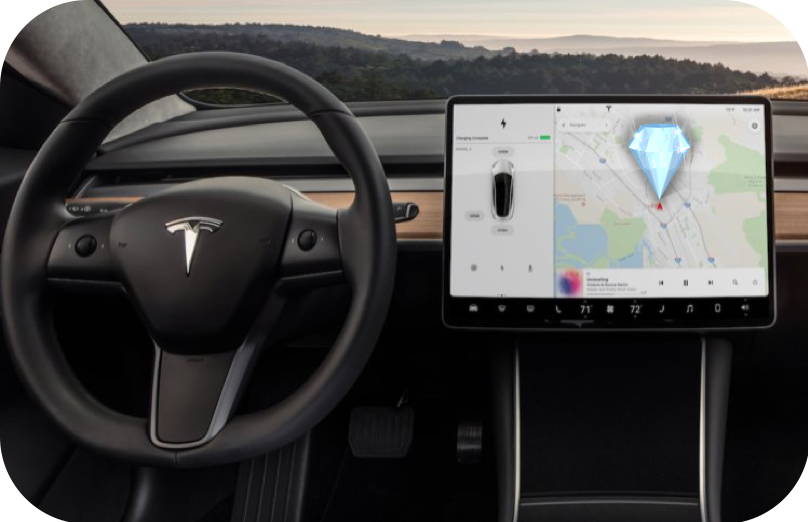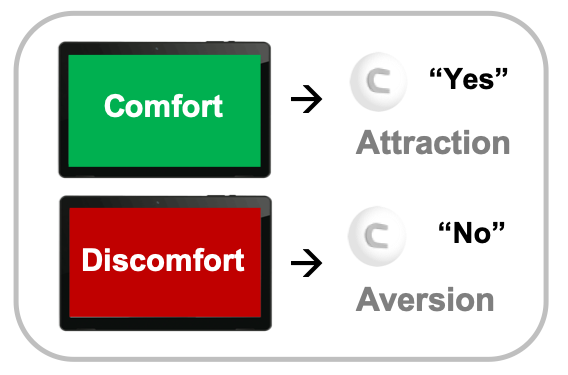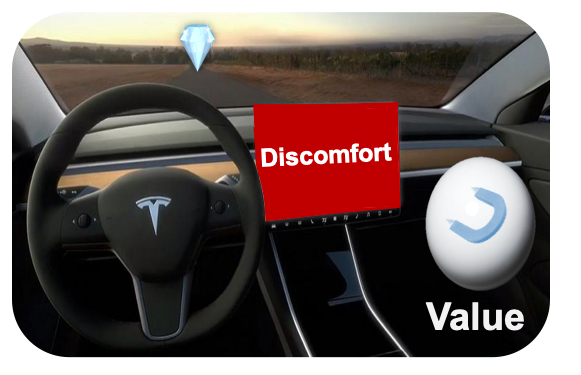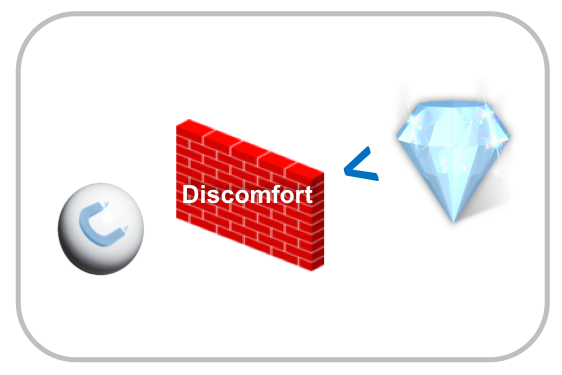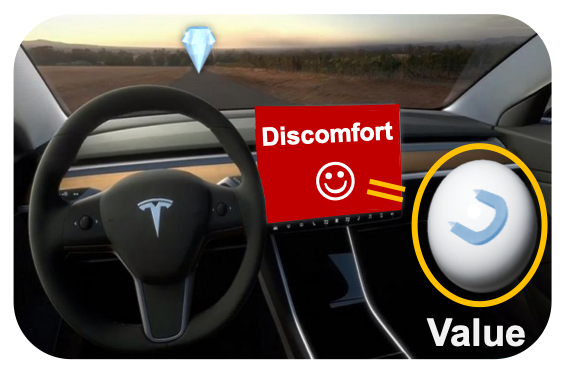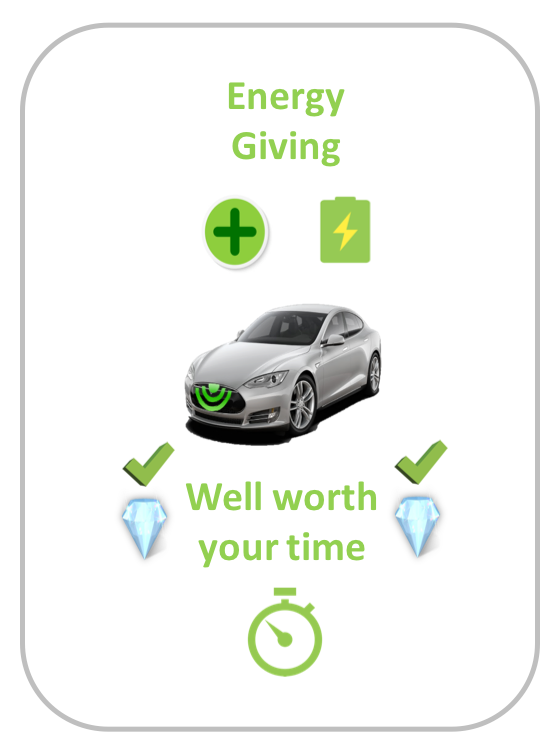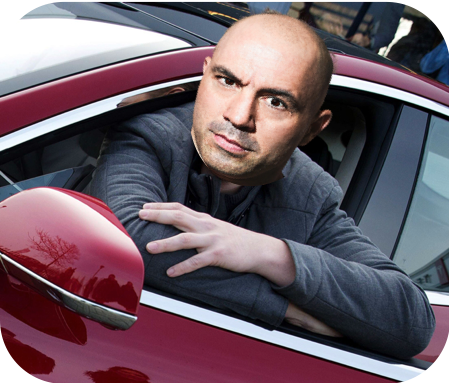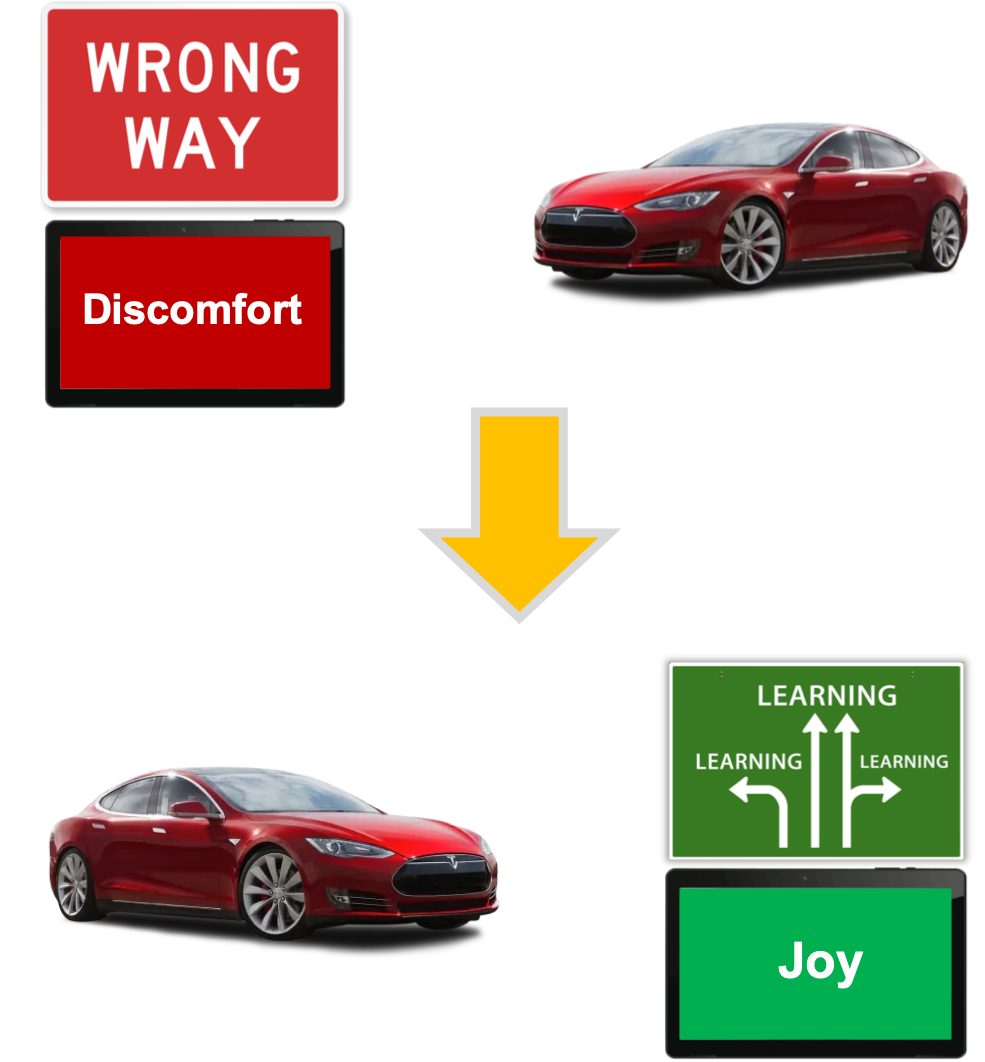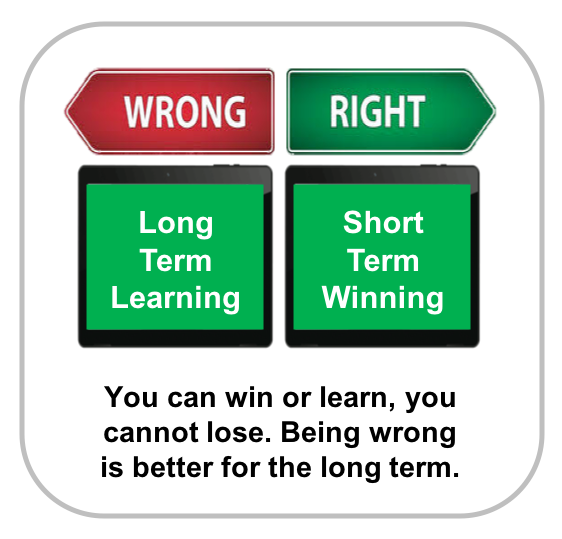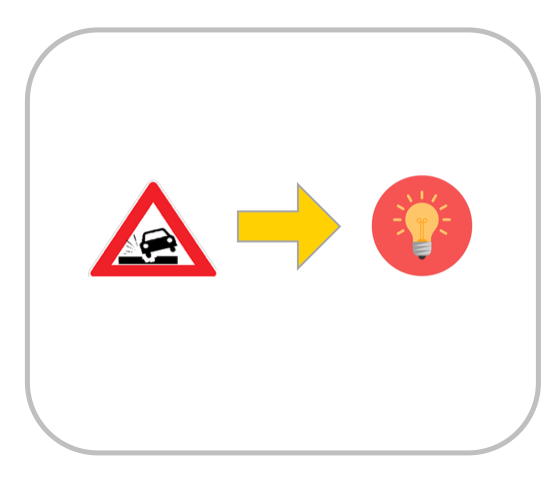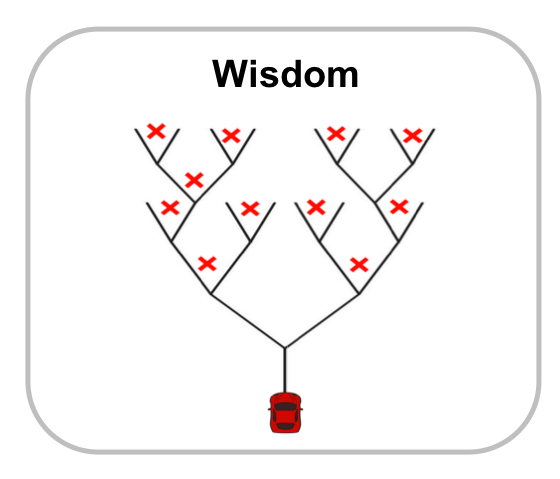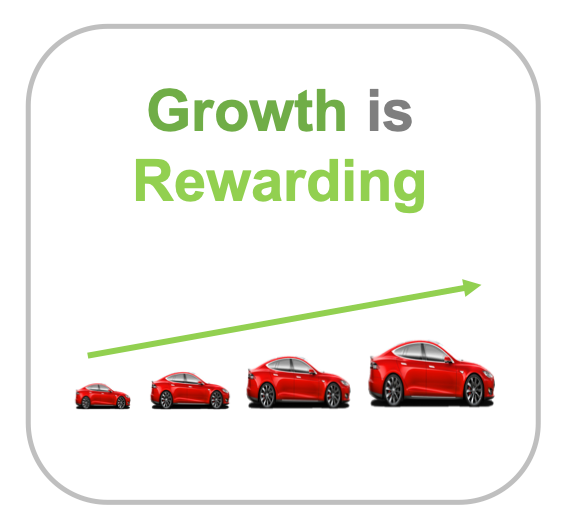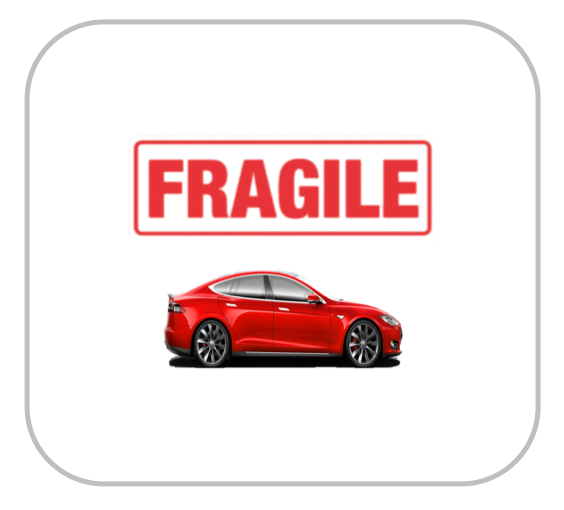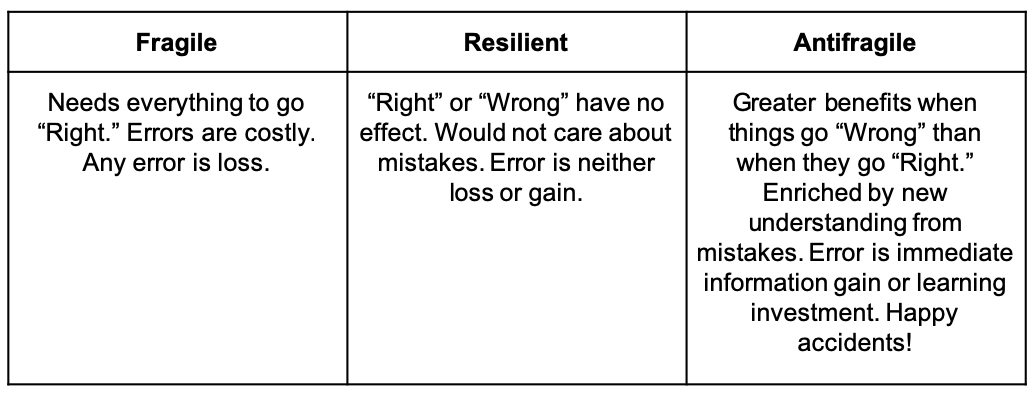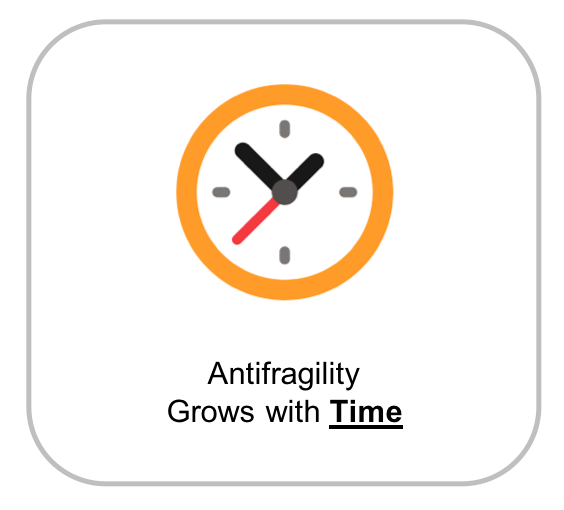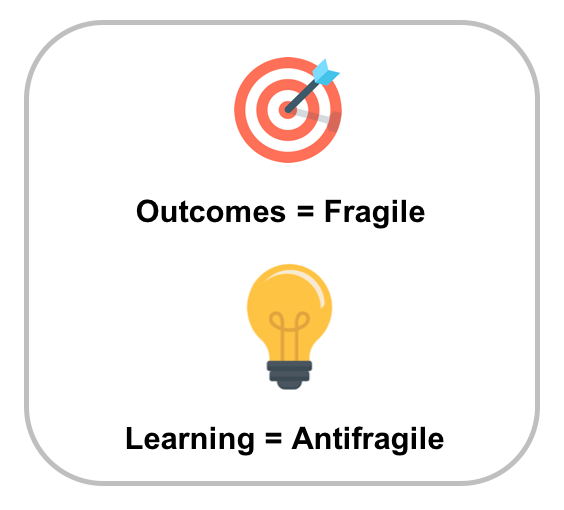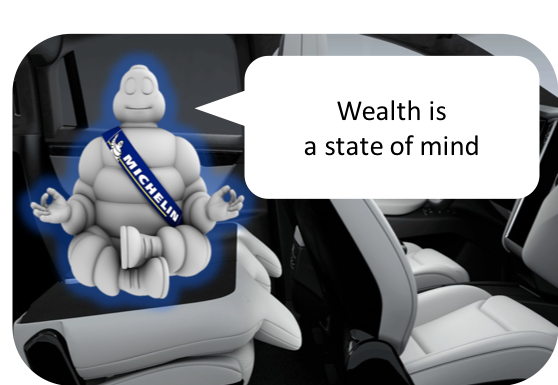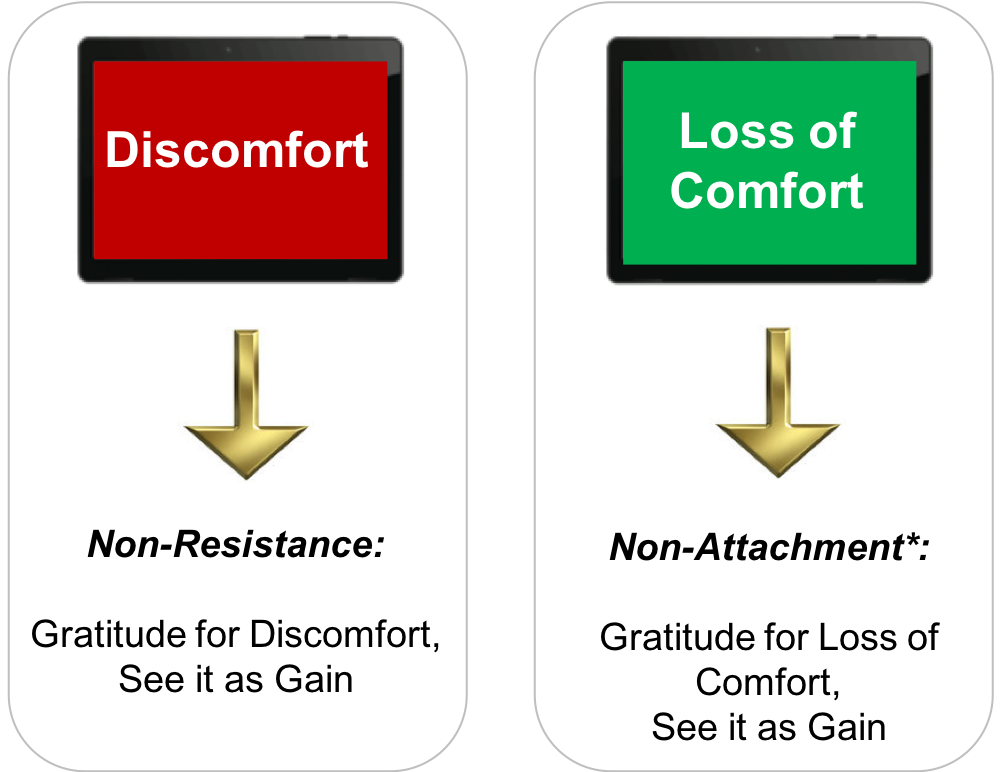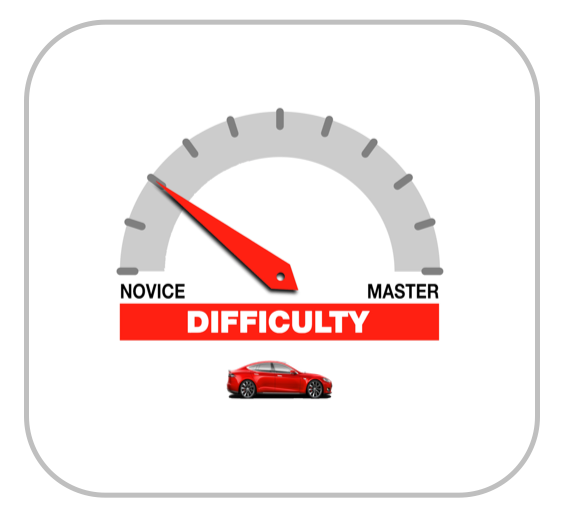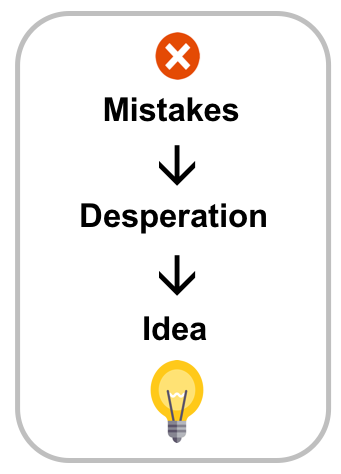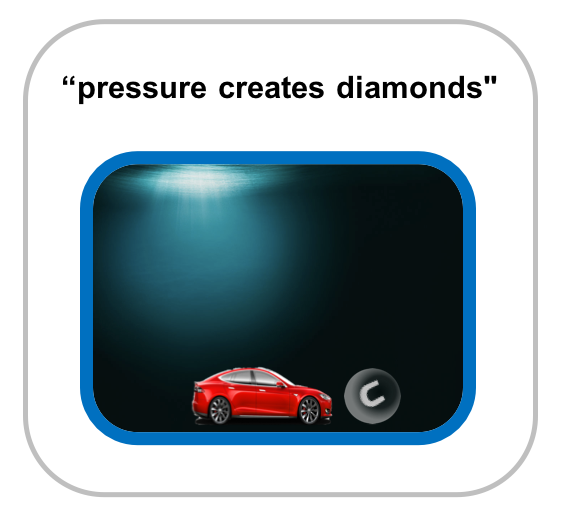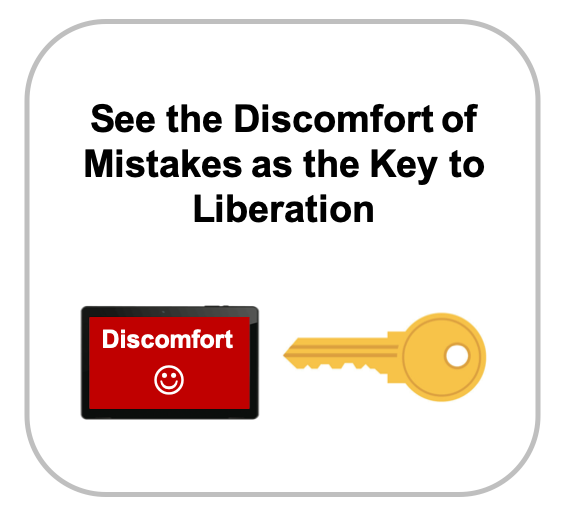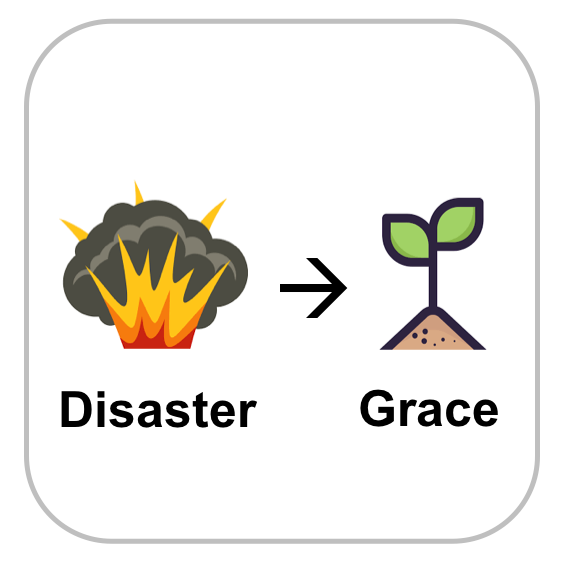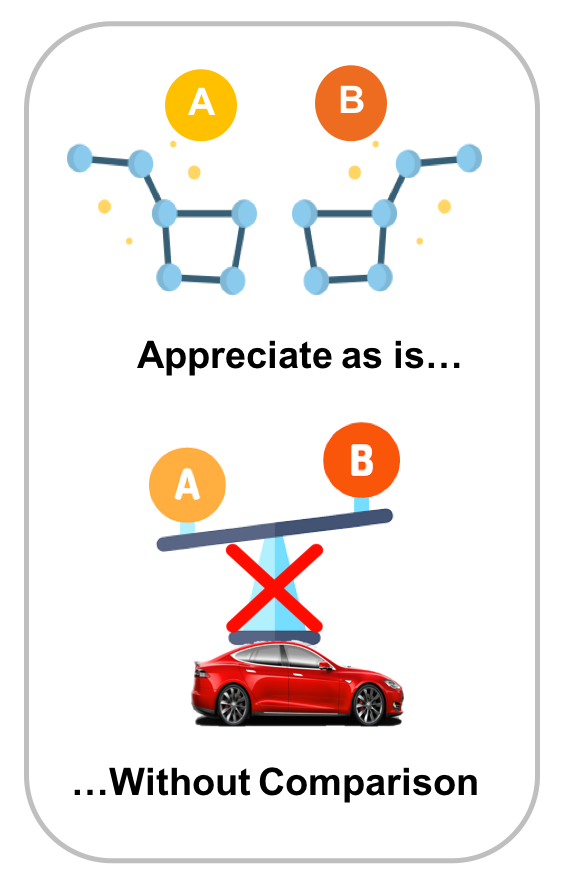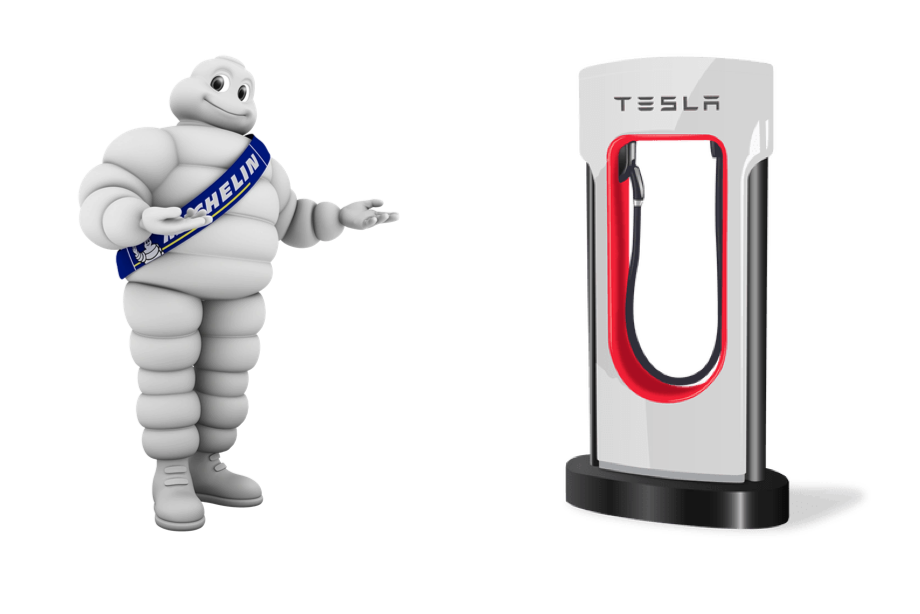Welcome to the game of life.
You are currently embarking on the grand adventure of existence.
Throughout this adventure, you will be making a series of decisions. At the time they are made, some decisions will seem “good,” and some decisions will seem “bad,” but the final result of all decisions cannot truly be known until the end of your adventure.
In this game of life, you can choose to play by one simple rule. The rule is that you choose to have faith that all of your choices will work out in the end. You can simply choose to have faith that all mistakes will be seen as correct decisions once you are done. In the words of Bob Ross, “there are no mistakes, only happy accidents.”
You can imagine that each decision in life is like a road. The roads are continuously branching out from each other, like the branches of a tree. Let’s represent you, the decision maker, as a car that drives along these roads. Let’s begin by learning about your car.
“Your own self-realization is the greatest service you can render the world.”
– Ramana Maharishi
As you are the driver of this vehicle, you have the responsibility to drive it well. The purpose of this chapter is to provide a basic orientation to your car, and encourage you to drive to your fullest potential.
The obvious thing you find in your car is the steering wheel. This represents your ability to make decisions. Take purposeful action that is aligned with your highest intention. Be the conscious driver of your life, instead of living on the habits of autopilot. Your decisions will not only take you to your destination; they will also shape and mold who you become.
Behind your steering wheel, you find your gearshift. Let us call this your “attention.” Being able to shift your attention well is fundamental to driving your car. Over time, your car will become a direct reflection of what you have chosen to focus on.
Above the steering wheel, you will find the speedometer. The speed of your car depends upon the energy of your body. Your energy is the most important resource for taking you to the places you want to go. If you want to have high energy, you must find a passion that excites you.
Within the speedometer, you will find the range icon. The ability of your car to go for long distances depends on how well-charged it is. Your car will only go far if you cultivate the required health habits. Every habit you have either appreciates or depreciates the health of your car. Invest in your energy for the long term. Treat your car like you would treat a real car.
If you look to your right, you will find the GPS system. This represents your future plans and goals. The goals you set will determine the course of your life, so choose your goals wisely. A car that is truly determined to reach its goal is unstoppable, while a car without a goal is aimless. But remember, the experience of the adventure towards the goal is more important than the achievement of the goal.
If you look upwards, you will see a rear-view mirror. This represents your past. The past is really just a “story” about your life. This story is not even a recording of events; it is a movie that is revised and modified every time it is replayed. You are the creator of your story, so use this to your advantage.
If you look slightly downwards, you will see the open road in your display. Your current driving condition is the present moment. The degree to which you are fully engaged with the present moment determines your results. It is only by losing yourself in the flow of the present moment that creativity is maximized.
Every car has its own unique perspective. What you think is reality is often just your own windshield. You do not experience events, you experience your own personal interpretations of events. If you want to change your life, change your perception. Keep your windshield as clear as possible.
Your car is full of blind spots. Unfortunately, you do not have an internal monitor for this as cars do. You must rely on other people to help you fill these blind spots. By finding out how other cars see the road, you are expanding your vision. You begin to see the road for what it is, instead of being blinded by the way you wish to see it.
When you drive with other cars, signal your desired intentions honestly and make them transparent. Communicate your intentions clearly so that people can see exactly where you want to go.
Your car will only go as far as its desire, so the key to your engine is inspiration. You must find powerful inspiration that activates your engine and makes you feel truly alive. The size of your dream will determine the size of your growth.
Inside of your car, you have a gift for other cars. Your life is about cultivating this gift and finding a way to give it to society. Living is about giving. Giving is the purpose of life. As Viktor Frankl writes, “the more one forgets themselves — by giving themselves to a cause to serve or another person to love — the more human they are. Self-actualization is a side-effect of self-transcendence.”
The tread on your tires is the amount of inner resistance you feel. Having inner resistance is like having a rough tire tread; you are always fighting against the road. When you find inner peace, your tire tread becomes smooth and you have no inner resistance to the road. Harmonize yourself with the road, instead of fighting against it.
To turn life into a joyride, remember to play. The purpose of life is not just to work toward a destination. The purpose of life is to play, have fun, and enjoy the ride as you go. The best moments of life are like music, they are experienced for the sake of themselves. In music, there is no final destination; each note is its own final destination. Remember to dance and enjoy the music of life while it plays.
In the big picture, all you really have in your life is your time. You are always spending time, so make sure it always used on something that is truly worth it. Your time is your most valuable asset. As Bruce Lee once said, “If you love life, don’t waste time, for time is what life is made up of.”
Now that we have covered some of the basic interior of your car, we will move to a more important question: who are the passengers in your car? In this book, these passengers will represent your desires and values. Let’s explore this further.
“Life devoid of struggles is a life bereft of happiness, because the value of happiness is realized only after discomfort”
- Sam Veda
There are two types of passengers that you have in your car. They are desires and values. Desires and values are like magnets, because they attract and repel us from things. Desires and values are similar, but they are not the same thing. Values are “higher desires” that are more meaningful. To represent this difference, values have been coloured blue and given diamonds on the end of the magnet.
For now, let’s begin by first talking about desire. Desire is the force that moves all of life. Every day, we are filled with a multitude of desires that push and pull us in different directions. Behind our every action is a motivation, and behind every motivation is a desire. Desire is life.
At a basic level, all humans desire to have pleasure and to avoid pain. Pleasure leads to attraction, and pain leads to aversion. Our motivation seems simple - pleasure pulls us, pain pushes us.
In other words, humans are attracted to comfort, and feel aversion to discomfort. However, if this was your only motivation system, you would would become weak and fragile, living only in your comfort zone.
However, we are not weak and fragile, because we take actions that are outside of our comfort zone in order to get something. What drives us to do this? The answer is our values. If we really value something that requires us to go through discomfort, we do it.
The great question of life is - can you find a life goal that is valuable enough to go through pain for ? Pain is inevitable in any quest for any value. So what value in life do you want to fight for ? What is meaningful to you ? What will your life purpose be ? These are the big questions to ask.
You are going to have to find something the pulls you through the pain every day. Something that attracts you like a magnet. A goal that gives you the motivation to persist.
When we search for a goal in life, we often ask the classic philosophical question, “what is the meaning of life ?” It may be that there is no objective meaning to life. The answer may be more subjective. Every human has their own individual meaning of life. It is up to you to create your meaning.
If you are a nihilist, who is a person who says that their life has no meaning, then you will not have much motivation. People who feel life is meaningless do not have motivational willpower. Nothing seems worth doing to them. Do not be a nihilist.
Other people spend their life chasing values that end up feeling meaningless later on in life. They realize that their values have been superficial. This is a waste of life, to not question the depth of your values. Find values that have depth, that will stand the test of time.
Ask yourself what you find inspiring. Who do you find inspiring ? Why ? What does it mean to make a lasting difference in this world ? What is your vision ? What is your dream ? What is your unique contribution ? What is your unique story ? Why will you exist ? You get to choose.
The obstacles in life are often not external, they are usually internal. Your own inner barriers are the walls that stand in your way. You have to push through your fears and limiting beliefs.
Some people stay stuck in their comfort zone all of life. They follow the desire to stay comfortable, so they do not grow. A comfortable road will keep us stuck and distract us from finding true value. If we are attached to comfortable habits, we will not grow and find fulfillment in life.
For people without meaningful goals, meaningless pleasure becomes the only goal. They get stuck in addictions. As Viktor Frankl wrote, “when a person can’t find a deep sense of meaning, they distract themselves with pleasure.” But eventually they realize that the desire for meaningless pleasure cannot fulfill them, and they start to seek true value over desire.
This can create an inner conflict between value and desire. Your mind becomes a place of battle. Part of you wants this, and part of you what wants that, and both cannot be satisfied. End the inner conflicts by choosing your deep values over your shallow desires.
In life, the hard path usually yields long term happiness. The easy path usually yield long term sadness. Invest in things for the long run. Think about the big picture. If you are on a purposeful path there is joy, even when nothing has been achieved yet.
The key to persistence is changing our relationship with discomfort. We must find a way to experience discomfort without inner resistance. Our inner resistance adds additional and unnecessary suffering to the discomfort. The antidote to mental resistance is deep acceptance. If you accept your discomfort, it does not bother you.
Being non-resistant is like saying “yes” to discomfort instead of saying “no” to it. It is about being open to it, fully allowing it to flow through you. You will notice that you can even be grateful for discomfort. Thank life for bringing you adversity.
The discipline to remain uncomfortable is the only way accomplish anything in life. As Jocko Willink says, “discipline equals freedom.” This is the paradox. The discipline that binds you temporarily is what frees you later on with rewards.
Disciplined habits will win over the long game. Create the habits that are needed to get you there. As James Clear writes, “Habits are the compound interest of self-improvement.” Each habit lifts you up or brings you down. Whether you win or lose, it will be based on the discipline of your habits.
The purpose of this chapter is to help you reflect on your values. Be clear on what they are. Don’t follow desires that lead you astray. Develop values that serve humanity. Take on the responsibility to help others. It is values that make us human, for without them, we are just self-serving animals of desire.
This is not to say that you should only be working and not having fun. This chapter is not suggesting that pleasure is bad. Hedonism is appropriate sometimes, just not all the time. Live a life of balance. Enjoy life’s pleasures. Have lots of fun. Just don’t do anything that goes against your deeper values, that’s all.
If you want to live a life of purpose, you will surely encounter discomfort for doing so. This adversity is what gives life meaning. As Viktor Frankl also says, “what man actually needs is not a tensionless state, but rather the striving and struggling for a worthwhile goal, a freely chosen task.” The beauty of life is in the struggle for greater value. The meaning of life is found from overcoming the adversity.
“Of all the means to insure happiness throughout the whole life, by far the most important is the acquisition of friends.”
- Epicurus
Ultimately, cars really just want to give and receive love. Our connection to one another is all that really matters. Social connection is a factor that is involved in every decision you make, even when you are alone. Although our cars appear to be separate, they are always deeply connected at all times. We are evolutionarily wired to form “tribes,” so we naturally depend on one another. The idea of a “lone wolf” or a “self-made” person is a false myth. As Martin Luther King Jr. says poetically, “We are caught in an inescapable network of mutuality, tied in a single garment of destiny. Whatever affects one directly, affects all indirectly.”
Neuroscience studies by Matthew Lieberman have shown that our brain processes social discomfort in the exact same way that it processes physical discomfort. Just as sociobiologist E.O. Wilson wrote, “the hardest thing for a human is to be kept in solitude. A person’s membership in their group – their tribe – is a large part of their identity.” This research strongly suggests that people need a group to belong to, so we must choose our tribe wisely.
In his “Hierarchy of Needs,” Psychologist Maslow placed “the need for love and belonging” in the middle of the pyramid. This need is hard-wired into everyone, so you must be aware that it can have a very powerful effect on your choices. It has been said that, “Love is the oxygen of the soul.” The problem with this is that the need for love and belonging can be in conflict with the need for “self-actualization.” People get involved in a group that hinders them from expressing their full potential. The group they are with may influence them to engage in bad habits, such as drug use. As leaving the group produces discomfort, people can stay conflicted between the needs of belonging and self-actualization for lengthy periods. Self-actualization is rare, because people want to fit in at the expense of their potential.
The influence that a group can have on the individual is expressed a lot in the world of personal development. An often-cited quote is one by Jim Rohn, who says that “you are the average of the five people you spend the most time with.” There’s certainly some truth to this, so be strategic in who you hang around with. People slowly become like their friends, so you have to find friends who challenge you to grow. Find people who provide you with a new and useful perspective on the world. Every person is either making you stronger or making you weaker. To be blunt, you need to find people who make you stronger. You can’t afford to be dragged down by anyone. You can’t afford to be devalued by anyone, because your worth is too high for this. Find friends with the same strong values as you, which will deepen your connection. This connection is itself even more valuable than any goal you could pursue together. Deep connection is worth more than gold. Real friendship is what makes life worth living.
You can think of social connection as the charger of your car’s battery. Nothing affects your car’s energy more than other cars. Each car you meet gives you a specific charge. The cars that give you a positive charge can be thought of as energy “amplifiers.” We can call them amplifiers because they increase the positive feelings you have. You want to share news and celebrate with amplifiers. The amplifiers are people who encourage you to reach towards the best version of yourself. They help you achieve your goals and are always there to support you. If your tribe is made of amplifiers, your growth will be exponential. Your friends are your most important investment. Amplifiers give you more energy, and time with them is well worth every minute. Simply put, Amplifiers make you stronger. In an ideal world, all cars would amplify each other. They would all be helping each other as much as possible.
However, we live in a world where some cars have a negative charge. This may seem harsh and judgmental, but it is useful for you to think of these cars as energy “vampires.” The term is simply a metaphor to describe how some cars drain your energy and make you weaker. As it is just a metaphor, please do not call anyone a vampire in real life. The term is just an analogy to help you think about their effects on your energy. The bottom line in life is that you must find amplifiers and avoid vampires. This will ensure that you maintain a high positive charge. However, in reality it is always unclear who is helpful or unhelpful. There are people who have good intentions, and try their best to be amplifiers for you, but they end up being vampires. It is not at all personal, it’s just negative energy. Or alternatively, their energy may be good, but they may ask you for more of your time than you can give them. You have two resources – time and energy. Maximizing your life means giving your resources to truly worthy people.
Healthy amplifier friendships have a sense of balance. Each person gives and receives value from one another. But if someone is just taking time and energy from you and not giving anything to you, then there is an imbalance. These imbalances may signify a vampire relationship. It would be best to leave a vampire relationship if it becomes clear that the person will not change. However, people tend to stay in vampire relationships because they do not want to go through the discomfort of ending them. They are afraid to nudge someone out of their life, and convince themselves not to leave the person. Spending time with someone you can’t afford to be with anymore is unnatural. You cannot allow someone to take your time and energy without giving something of value in return. You cannot afford to spend time and energy on people who are not worth it for you. Life is too short. Gently nudge out the vampires and find amplifiers.
When things inevitably go wrong in relationships and you must leave each other, forgive one other and leave on good terms. This allows you to move on with peace of mind. As Mahatma Gandhi says, “forgiveness is the attribute of the strong.” Forgiveness allows life to peacefully flow again. Nothing creates a stronger foundation in society than gracious forgiveness. As Bruce Lee says, “mistakes are always forgivable, if one has the courage to admit them.”
When things go wrong in relationships, do not take anything personally. Life is a game of musical harmony, and
not all music notes have harmony with each other. You can simply recognize that your values were not a match with one another. As the philosopher Cicero wrote, “It is virtue which both creates and preserves friendship. On it depends harmony of interest, permanence, and fidelity.”
When things come to an end, be thankful for the lessons that the person gave you. If you are humble, you can see every person you have met as a “spiritual teacher” of some sort. And when you realize that you have been spending time with the wrong type of person, you are gaining self-awareness about who the right type of person would be.
And when you find the right type of people, stay committed to them, for they are worth more than anything in the world. Find people who resonate with you and appreciate them deeply. As Joe Rogan once said, “The key to happiness doesn’t lay in numbers in a bank account, but in the way we make others feel and the way they make us feel.” The purpose of life is to give love, and those who give love usually receive love. But the only love you truly need to receive is love from yourself. Love yourself unconditionally, regardless of how much discomfort you create for yourself from mistakes. If others can forgive you, then surely you can learn to forgive yourself.
“The most valuable thing you can make is a mistake – you can’t learn anything from being perfect.”
– Adam Osborne
Discomfort is not only the creator of value, but is also the catalyst of learning. Although our instinctual mind tries to avoid discomfort, discomfort will find us and force us to learn from it. And if life is not giving us discomfort, we create our own discomfort through our mistakes. This discomfort may be the hardest of all discomfort, because we were responsible for its creation. However, the discomfort from our “wrong” choices is the discomfort that helps us grow the most. The discomfort of our mistakes leads us into deep reflection. It is through the discomfort of our mistakes that we learn the lessons we need to learn.
If we could live life our way, we would probably just choose to do everything the “right way,” and not experience the discomfort of mistakes. But if we did not experience discomfort, how could be grow? If we accept that discomfort is the only path to growth, and it can’t be any other way, then mistakes are fundamental. Mistakes can be seen as the mandatory portal for learning. But this requires that we see discomfort as the only way to learn. If we see discomfort as an absolute necessity for learning, we can begin to embrace our mistakes. We can see that mistakes lead to discomfort, discomfort leads to growth, and growth leads to joy.
The goal of this book is to help you enjoy your mistakes, so that you can enjoy all of life unconditionally. If mistakes are the only way to learn, then we cannot lose. We either win or we learn. We can think of each mistake as an investment in your wisdom. The discomfort created by each mistake guides us away from repeating the action, so we are better prepared for the future. The mistake is uncomfortable in the moment, but our future will be more pleasurable because we have learned. Being wrong is a long-term investment for our learning, while being right is just a short-term win. From this perspective there is only upside; we can only gain and can never lose. Mistakes are the currency of our wisdom, so we hope to make more of them to become wealthy in knowledge.
The best description of the role of mistakes in learning is by legendary investor Ray Dalio. Dalio’s Twitter bio currently includes the phrase “professional mistake maker.” Dalio’s philosophy is based off a pivotal namistake. After starting his company in 1975, he went broke in 1982 after being massively wrong about the direction of the economy. Dalio later said that the huge discomfort of this mistake was the best thing to happen to him, because he learned deep humility and wisdom. The mistake completely changed his mind-set and approach to investing. After recovering from this mistake, Dalio turned his company into one of the world’s largest hedge-funds.
Dalio’s best-selling book “Principles” mentions the word mistake 148 times. Mistakes are essentially the core theme of the book, as Dalio equates mistakes with learning. To Dalio, mistakes are “beautiful,” and learning from mistakes is like solving a puzzle to unlock a gem (a “principle”). Dalio says you are lucky to feel discomfort after making a mistake, because you being given the signal to reflect deeply. He encourages his employees to love their mistakes, as they are the only way to improve. Mistakes are seen as exciting learning opportunities.
Dalio strongly encourages creating a culture that praises mistake-based learning. This environment is one where people feel safe to make mistakes, but it is unacceptable not to learn from them. The absolute worst thing you can do at his company is hide a mistake, because you are stopping the learning process. The most important tool in Dalio’s company is the “issues” log, which tracks mistakes to understand them systematically. It is the number one priority for Dalio to hire self-reflective people who can embrace their mistakes and learn from them.
Dalio says that examining the patterns of mistakes is useful because it can signify potential weaknesses. This is also an ego barrier, because people do not want to admit to weaknesses. This ego barrier must be overcome to make weaknesses transparent. People should appreciate accurate criticism. When weaknesses are transparent, you can design systems to work around them so that they do not stop you from achieving your goals. Weaknesses can also be seen as opportunities to improve, if possible.
Dalio says that we can convert the discomfort of seeing our mistakes and weaknesses into pleasure. The pleasure of progress can overcome the discomfort involved with deeply examining these mistakes and weaknesses. If the pleasure of growth outweighs this discomfort, we can train ourselves to enjoy reflecting deeply on mistakes and weaknesses to gain insights. We have to enjoy the process of finding the root causes of mistakes so that we can prevent them in the future.
Dalio emphasizes taking a long-term perspective on mistakes, where mistakes are seen as fundamental to the evolutionary process. When your focus is short-term, you will focus on the bad outcome due to the mistake. When your focus is long-term, you will focus of the learning opportunity and be grateful for the lesson. All mistakes are learning investments that save you from making more mistakes in the future.
Dalio encourages us to not feel bad about your mistakes or those of others. He even says that we have to love these mistakes. He tells us to remember that 1) they are to be expected, 2) they’re the first and most essential part of the learning process, and 3) feeling bad about them will prevent you from getting better. Relentless persistence after mistakes is mandatory for success. In his notes, Dalio has a quote by Thomas Edison that reads, “I have not failed. I’ve just found 10,000 ways that don’t work.”
Dalio’s philosophy is essentially about gaining through discomfort. He believes that discomfort is required to become stronger. However, he clarifies that this does not mean that more discomfort is necessarily better. He believes that too much discomfort can overwhelm someone, but also believes that the absence of discomfort typically prevents growth. So we have to trust that our mistakes are giving us the appropriate amount of discomfort to become stronger.
Dalio says that it is a fundamental law of nature that to evolve, one has to push one’s limits, which is uncomfortable, in order to gain strength. He says that nature gave us discomfort as a messaging device to tell us that we are approaching, or that we have exceeded, our limits in some way. At the same time, nature made the process of getting stronger require us to push our limits. Gaining strength is the adaptation process of the body and the mind to encountering one’s limits, which is uncomfortable. In other words, both discomfort and strength typically result from encountering one’s barriers.
Dalio tells us to remember that the discomfort you are feeling will lead to the reward of personal growth. He recommends trying to look at uncomfortable problems as a detached observer would, fully accepting your mistakes and weaknesses that may have caused the discomfort. It is important to see yourself objectively. We need to deeply understand that no one is perfect, and understand that these uncomfortable discoveries are essential for growth. If we can understand this, then we can find that these uncomfortable discoveries create “growing pleasures.” Focus on the beneficial long-term outcome, and the short-term discomfort begins to be outweighed by the pleasure of learning.
We all know that mistakes are inevitable, but Dalio suggests that it’s important to deeply recognize and accept this fact of life. However, he says that the good news is that most learning comes through making mistakes — so there is no end to learning how to play the game better. As Dalio says, “mistakes are fuel for improvement.”
So when we read Dalio’s “Principles,” we see that success is all about making mistakes, and having a growth mindset in response to them. As Saint Augustine says, “I err therefore I am.” In other words, error is life. So if mistakes are what life is all about, we can logically say that you must love mistakes in order to love life. We can learn to enjoy our time at the University of Mistakes if we learn to let go of our mental resistance to mistake-making. Our default condition is to dislike mistake-making, but we can train ourselves to be “mistake-loving.” If anything can be learned, then it is in our highest interest to learn to be a mistake-lover. Your relationship with mistakes is the most important relationship you have.
Many people say that “life is about the journey” and not about the “success.” And many people say that the journey is full of “failure.” So if we want to enjoy this journey, regardless of a successful outcome, we need to learn to embrace the inevitability of “failure.” If it is about a journey of failure, then maybe true success can be measured by the attitude one has in failure. As Winston Churchill wrote, “success consists of going from failure to failure without loss of enthusiasm.” We must train our minds to enjoy failure, because the person who can enjoy all conditions of life is truly successful. Although we have goals within the game of life, our higher goal in life is really just to have the best experience that we can. So if you want to have the best experience that you can, you are going to have to learn the art of mistake-appreciation.
Appreciating mistakes is very difficult, partly because schools are always teaching students to avoid mistakes. Dalio theorizes that schools overemphasizing the value of having the right answers all the time. Students that are used to being right are often the worst at learning from their mistakes. They have been conditioned to associate mistakes with failure instead of opportunity, creating a “mistake phobia.” The inability to embrace mistakes is a large ego barrier that substantially decreases progress.
My perspective is also that the education system teaches kids to be over-sensitive to mistakes. Most subjects are graded as “correct or incorrect,” which “punishes” kids for being incorrect. Instead of seeing more “wrong” answers as a bigger learning opportunity, kids just end up feeling like bigger “failures.” They begin to see all of life as “correct or incorrect,” and begin to fear mistakes because of the consequences. They begin to define success as the “minimization of error,” because they were rewarded for this in school. However, in the real world, innovation is often created by trial and error. In trial and error learning, the errors are the prizes, which is the opposite of school tests.
To learn the art of mistake appreciation, you have to first unlearn the habits created by your formal education. If your definition of success is “error minimization,” this will make life fragile. It is a recipe for disappointment, because big errors will be made. It is a bubble that inevitably bursts. The neediness to do the right thing all the time is a burden that breaks people. If kids believe that they have to errorless, they will always be anxious and fragile. But at our core we are not fragile; we are the opposite. Instead of fearing error, we can embrace it and gain from it. This attitude is the opposite of fragile. And your car wants to be the opposite of fragile.
“Don’t aim to be perfect! Aim to be antifragile.”
- Nassim Nicholas Taleb
One way of learning the art of mistake appreciation is by understanding your “antifragile” nature. The concept of antifragility was created by philosopher Nassim Taleb. Taleb created the word “antifragile” to describe the opposite of fragility.
We all know what the word fragile means, but many people do not know the true opposite of fragility. When Taleb asked most people what the opposite of fragility is, they might say something like “robust,” “resilient,” or “solid.” However, he says that these definitions are not the true opposite of fragility, because they are simply unharmed by stressors. He says that a true opposite of fragility would be something that actually improves from stressors. It would be like a package that would say, “please mishandle.”
To illustrate the concept of antifragility, Taleb breaks life down into three categories, which he calls “The Triad.”
I will describe them in easy to understand terms here:
Let’s use car examples to explain these concepts:
Whereas a real car depreciates from usage, your Mind-Body Car depreciates from a lack of usage. In other words, the Mind-Body Car needs some measure of stressors to be healthy. The everyday example we used in the triad earlier was “going to the gym.” By lifting weights, muscles are (supposedly) torn so that they are built back bigger and stronger. This is the basic process of antifragility.
The concept of antifragility can be summed by the well-known quote, “that which does not kill us makes us stronger.” Of course, this is not true in all situations, but it does apply to many. Remember that antifragility is dose-
dependent. Too much weight can crush you, but a heavy weight that you can lift will make you stronger. It is very important to map out where your car is uniquely fragile and antifragile. Take care of your fragilities, and take advantage of your antifragilities. Give yourself the right dose of stress, but do not overload yourself.
Another word for stress is pressure. The only way we are motivated to grow is when we are under pressure. If you want to grow, you must put yourself in situations which have the right amount of pressure. The fragile will break under pressure, the resilient will survive it, and the antifragile will thrive because of it. If you have no force that is pushing you, how can you be strong? Life must pressure you; you will not grow on your own. You will lift your maximum weight only when you must.
Taleb mentions many more words to describe stressors and disorder, such as volatility, randomness, uncertainty, risk, chance, turmoil, entropy, and time. A single word to describe these might be disorder. The antifragile gains from disorder, while the fragile needs perfect order. As life is full of disorder, the antifragile is in harmony with life, while the fragile is only at peace when it finds perfect order (which is very rare in life).
Disorder is very common in life, because we are constantly making mistakes. However, Taleb says that the antifragile “loves making mistakes,” because it loves disorder. For the antifragile, errors are welcomed as a rich source of information. The more you know what doesn’t work, the closer you come to the solution. Each mistake makes you wiser, and because you are not fragile, you are not harmed by the mistake. Learning happens through trial and error, because each trial shows what does not work. Eventually the solution is found, or alternatively, the errors themselves become accidental discoveries. In trial and error learning, error is what we love. The antifragile loves mistakes.
In terms of relationship to error, the triad looks like this:
Description
Character Examples
The challenge of this book is to figure out how to shift your car into the antifragile column. How can you learn to love mistakes? How can you create positive reactions to error? How can you convert disaster into opportunity? How can you use mistakes as fuel for improvement? There are no easy answers, and this is the challenge of a lifetime. Small mistakes are easy, but big mistakes are very difficult. But you are equipped for the challenge. See each mistake as a spiritual exercise, and trust that your mistake loving abilities will grow with time. Never underestimate your ability to love a mistake in the long run. It always takes time.
One of the core reasons that people are fragile in life is because they care more about outcomes than they care about learning. Outcomes will rarely go our way, but we can always learn regardless of outcome. In fact, we learn more when the outcome does not go our way than when it does. If you truly prioritized learning, you would actually prefer things to go wrong than to go right. And if you truly care about learning more than you care about results, you are antifragile. Learning is always a gain and never a loss. As Buckminster Fuller says, “Mistakes are great, the more I make the smarter I get.” To level up in wisdom, you have to make mistakes.
Mistakes also lead you to level up in mental toughness. Mistakes lead to discomfort, and discomfort always leads to antifragility. So when you make a mistake and experience discomfort, you can assume that this is life’s only way of making you tougher. As David Goggins says, these experiences create calluses in the mind, leaving it stronger than before. So you can see each mistake as a weight that is testing the strength of your character. Will you gain from your mistake, or will you lose from it?
Asking whether there is more to gain than lose is the simple test of antifragility. If there is more to gain than to lose from your mistakes, you are antifragile. If there is more to lose than to gain from mistakes, you are fragile. Therefore, the antifragile mind is always gaining more than it is losing from its mistakes. This means that the antifragile mind needs to make mistakes, because this is the only way it can gain wisdom and strength. Depriving the antifragile of the opportunity to make mistakes is depriving it of its growth.
It is always essential to think about fragilities and antifragilities over the long term. The general rule is that challenges lead to the long term appreciation of your car, while effortless conditions lead to long term depreciation of your car. The hard road leads to antifragility, while the easy road leads to fragility. You have more to gain from challenges than you have to lose, so keep pushing yourself outside of your comfort zone. However, you must also rest and recover after challenges to stay balanced.
Let’s now apply antifragility to chapter two. Chapter two essentially describes our values as being antifragile to discomfort. When we take uncomfortable actions for our values, the values become stronger. For our values, discomfort leads to gains. Our values need discomfort to grow. As there is only gain from discomfort and no loss, our values are antifragile.
On the other hand, chapter two shows us that our desire for comfort makes us fragile. The desire for comfort leads to fragility because it can lead to attachment. Attachment makes us fragile, because we experience suffering when we lose what we are attached to. As we know that losing the attachment causes suffering, we cling to the attachment and avoid losing it. In the long run, this is a situation where there is more to lose than to gain.
Ancient philosophies understood that humans are fragile to losses, so they tried to decrease fragility by becoming more “mentally immune” to them. Taleb describes stoicism as one of these strategies, and gives the example of Seneca. Seneca often repeats the phrase “I lost nothing,” after adverse events (ex: shipwrecks). He saw our possessions as unnecessary, and believed we can always rid ourselves of anything without feeling the loss.
If a person becomes “immune to losses,” they are at least resilient, but if they also find a gain then they are antifragile. For example, Seneca would say that he gained more than he lost after these disasters. Seneca seemed to understand antifragility, as he deliberately trained himself to live in harsh conditions. While he trained himself to embrace adverse conditions, he felt that his gains in strength outweighed the temporary loss of lifestyle.
Taleb says that the idea of Stoics being antifragile differs from traditional views of Stoicism. Many people interpret Stoicism as just having the goal of resilience. They see it as an indifference to fate, in which one is unaffected by both good and bad. This interpretation leads to criticisms of Stoicism as being emotionless (like “vegetables,” as Taleb says). However, Taleb describes the antifragile Stoic as a person who has “domesticated” emotions instead of eliminating them. They have trained themselves to always see the emotional upside, and are always gaining from any event.
Antifragility resonates deeply within the soul. We do not want to simply survive stressors, we want to thrive because of them. We do not want to simply break even with stressors (resilience); we want to always gain from them (antifragile). The question is, how we do we develop the antifragile mindset? How do we not see loss and only see gain? How can we develop this perspective?
As we seek answers to these questions, we can examine the antifragility of other philosophies. For example, Buddhism has similarities to Stoicism. Was the Buddha antifragile? Or just resilient? There is no clear answer, but there seems to be some indication that the Buddha was antifragile. We can see antifragility in Zen sayings such as, “No Mud, No Lotus.”
Like Seneca, a modern Buddhist may become a temporary monk to reduce their fragility to wealth. By practicing hard living conditions, they can see that they do not actually need much wealth and would be ok if they lost it. This leads to less attachment to wealth, and less attachment leads to less fragility. Of course, wealth should still be enjoyed, but one should know that they will still be fine without it. And if you learn to part with your wealth, then you are able to give more richly to others.
In the story of the Buddha, he tries to gain spiritual liberation by renouncing all of his wealth permanently for enlightenment. But he later realizes that this is not the answer. Instead, he realizes that wealth should be enjoyed, but the person must be emotionally unattached to wealth to be free from it. To be unattached would mean that they are not emotionally affected by losses. To test if you are attached, see what happens when you lose money.
To be truly wealthy, one must have the antifragile state of mind. If you practice the art of detachment, you can become immune to losses in life. And if you cannot lose, then you can only gain. In each loss there is an opportunity, you just have to train yourself to see it. You must always see more upside than downside in every event. Wealth is ultimately a state of mind. It is about finding an inner state of appreciation and gratitude, even in loss. No matter what happens, be appreciative and grateful, and you are always wealthy.
To find unconditional gratitude is not easy, but this is the goal of true spiritual antifragility. It is unconditional gratitude that transforms our losses into gains. Gratitude is the direct opposite of resistance, which makes it an alleviator of suffering. Your reaction to every event lies somewhere on the spectrum between resistance and gratitude. If you are in resistance, you are fragile to life’s stressors. If you are accepting, you are resilient to life’s stressors. But if you are grateful, you have become antifragile to life’s stressors. To be in the “gaining” antifragile mindset, we must always be grateful.
We can see the theme of gratitude in both Stoicism and Buddhism, and of course, Christianity. It is only through gratitude that true antifragility is expressed. If you merely accept stressors, you are just breaking even with them. If you are thankful for them, they are benefiting you. We cannot control events, but we can always learn to cultivate gratitude. Gratitude can alleviate your suffering, because it reduces your inner resistance to reality.
As Seneca says, “Nothing is more honorable than a grateful heart.” When we say that we are grateful, we are declaring that the current reality is plenty and that we do not need more. Gratitude ends our perpetual desire and hunger, which ends the fragility of neediness. When we are grateful we are finally satisfied. As Seneca also says, “It is not the man who has too little, but the man who craves more, that is poor.” Gratitude is true fulfillment.
It is hard to find out exactly what the Buddha said about gratitude, but we can guess he would say that it is medicine for suffering. Instead of limiting gratitude to the “good” times, we can practice it in the “bad” times as well. When we are grateful, we do not feel scarcity or loss. To be truly antifragile, we must be grateful even for all discomfort. We must thank life for its many challenges.
No matter what you believe about life, you will still feel good when expressing gratitude to life. As Meister Eckhart says, “If the only prayer you ever say in your entire life is thank you, it will be enough.” Gratitude puts our heart in a state of appreciation of the incredible gift of life. But often the gift of life involves discomfort. To be antifragile is to be unconditional in our gratitude, thanking life for the uncomfortable gifts. You are thankful to receive discomfort, because this leads to growth.
We can see from all of these spiritual teachers that gratitude is a core virtue. We must practice gratitude in both the good and the bad. As Seneca says, “In all things we should try to make ourselves be as grateful as possible.” As gratitude is the only way to become truly antifragile, we must learn how to practice this in challenging conditions. The Antifragile Mind is grateful for all adversity.
The Antifragile Mind
*The stance of non-attachment is referring to outcomes, results, money, possessions, etc.
It is not referring to people and relationships.
Gratitude is a spiritual muscle. It is easy to be grateful for the “good,” but it is hard to be grateful for the “bad.” Our job is to build up the gratitude muscle as much as possible, becoming grateful for even the worst circumstances. The heavier the circumstances one learns to be grateful for, the more the gratitude muscle grows. See the weight of life as a gift. Everything in life is a tool for growth.
To summarize, the antifragile philosophy is essentially about seeing life as a spiritual gym. Every challenge that life gives you is life providing a weight for you. Life always has your best interest in giving you the weight, because life wants you to become stronger. The bigger the challenge, the bigger the growth. Some weight will seem too heavy, but you will surprise yourself and lift it. You lift until the point of failure, because that is the moment where you gain.
You can resist the weight, accept the weight, or be grateful for the weight. Your experience in the gym of life will be determined by the attitude you cultivate. Never wish life was easier, be thankful that it is difficult. Beating an easy game is not fun and unrewarding, but beating a difficult game is very fun and rewarding. Do not be envious of those who seem to be playing an easier game, for they will not receive the joy of overcoming big challenges. Take pride in the strength you have built without comparison to others.
The great joy of life is to gain from adversity. When life gives you bigger weights, it is giving you a bigger opportunity to become more antifragile. You will gain most by dealing with the unexpected. As Arnold Schwarzenegger says, “you have to shock the muscle!”
As you first start out in the gym of life, you will lift improperly and create discomfort for yourself. The discomfort of these mistakes is the force that guides you. The discomfort of mistakes help you navigate your strengths and weaknesses. We are grateful for this discomfort, because we are lost without it. The discomfort refines us, it sculpts us. For all of life we are grateful, because we know that true antifragility is found only in this spirit of gratitude. We are thankful to have the opportunity to live in all circumstances. We are thankful to have the opportunity to grow and give to others.
“It is by going down into the abyss that we recover the treasures of life. Where you stumble, there lies your treasure.”
- Joseph Campbell
Taleb says that “my idea of the modern Stoic sage is someone who transforms fear into prudence, pain into information, mistakes into initiation, and desire into undertaking.”
This idea of turning mistakes into initiation is very important and useful in life. You can think of each mistake as “an initiation point” which launches a new direction in your life. The greater the discomfort of the mistake, the more the initiation will transform you. What this means is that the greatest growth in your life may actually come from accidents. It may actually be your stupidity that leads to your greatest gains in mental toughness. The saying goes, “If you’re dumb, you better be tough,” but you could also say, “if you’re dumb, you’re gonna get tough eventually.”
The reason for this is that your mistakes can lead you into a situation of desperation. And it is desperation that motivates much more than inspiration, because desperation is an instinctual attempt to escape pain. If necessity is the mother of invention, desperation is the father of brilliance. No one voluntarily chooses to be desperate, but once they are desperate the innovation begins.
When your mistakes lead you into desperation, it is like falling into a pit that you have to climb out of. In this case, you need to take the “Hero’s Journey” and climb out, or else you are trapped in despair. The “Hero’s Journey” is an archetypal story pattern, common in ancient myths as well as modern day adventures. The concept of the Hero's Journey was described by mythologist Joseph Campbell in his book “The Hero with a Thousand Faces.” What is particularly interesting about the Hero’s Journey is that the hero often does not want to go on the journey in the beginning. This resistance to heroism is known as “The Refusal of the Call.” The future hero really wants to stay ordinary, but life finds a way to pressure them into becoming extraordinary. It’s the desperation of life that pressures them.
When life pressures them enough, the hero must make a leap of faith into the unknown. There is no easing into it, it is a yes or no decision. The hero must have faith that they can handle the uncertainty. They must have faith in their antifragility. Nothing is guaranteed, because to be a hero is to choose the uncomfortable and the risky. There has to be faith that the ordeal will lead to transformation. The hero must go through significant discomfort to access their newfound strength. This transformation must be seen as being worth the discomfort.
No one really wants to go through an ordeal, so most people end up in the abyss by mistake, accident, or unexpected disaster. The ordeal is thrust upon them by life, and it is in this moment where they can refuse the call or answer it. But if they resist the call, they will not take pride in themselves, so their internal sense of responsibility pressures them to take the call. Life is testing them, even though they may not have signed up for the test. The hero does not want to hit this “rock bottom” moment, but it is only there that they find their heroism. The deepest lessons are in the bottom of the pit, not at the top of the mountain. But why is this how life works?
In the language of this book, the explanation would be this - the discomfort of rock bottom is what helps the hero find their deepest value. We can’t find deep value in comfort, because deep value is created only by discomfort. So then, life must be hard. If life was not hard, it would not be rewarding to overcome it. The difficulty of life is where the joy is. If you did not have to overcome a challenge to obtain a reward, then you would not have earned it. And it is only when you have struggled to earn it that you truly value it. And even if there is no external reward, the reward of becoming strong is internally rewarding enough to make the ordeal worth it. Who you become is worth more than gold.
However, we seem to only realize that the struggle is worth it after we do it. Before we do it, we convince ourselves that we should just take the easy path. Humans do not like to sign up for voluntary struggling, so we need to be pressured into a situation of struggle. Sometimes the only way into these situations of desperate struggle is through our mistakes. The mistake is often the only way to create the challenge, so that we unlock our full potential. In the long-term, the best thing you can do is make mistakes, because your attempts to recover from them are what force you to grow the most.
You also benefit society the most when you make mistakes, because you can tell people what not to do. Every mistake is an opportunity to be heroic by telling your story about it. The irony of society is that we only praise the “intelligent” people, but the “dumb” people that make mistakes are also providing information for others. The greatest mistake makers show society what not to do, which keeps others safe. They didn’t mean to do this, but their results are useful nevertheless. In the same way, you must praise the “dumb” parts of yourself, because your stupidity exposes you to new information that you would not have seen otherwise. Mistakes have great “information rewards” that you can’t see if everything goes as planned. If your mistakes lead you to fall into a pit, you can thank your “dumb” self for giving you the opportunity to learn how to climb out. The “dumb” parts of yourself lead to desperation, which leads to creativity and grit. So if your goal is to innovate, don’t be so smart that you always do things the “right way.” It is only through your foolish mistakes that you will accidentally initiate a hero’s journey. If you learn to appreciate mistakes as invitations to be heroic, you will truly enjoy life. Maybe it is too difficult to enjoy the mistake at the time, but maybe you can enjoy the memory of the experience afterwards.
Young people come into life expecting that they will be smart, but eventually they realize they are dumb. By the end of life, everyone realizes that they are dumb. So growing up is the process of being humbled. Your expectations of being smart slowly become shattered, as they should be. This eternal humbling process could be seen as one life-long Hero’s Journey – “The Hero’s Journey of Self-Acceptance.” The journey of self-acceptance is about watching life break your ego. Having high expectations of oneself makes a person fragile, because orderly expectations will not hold up to the chaos of life. High expectations are a setup for various forms of resistance, such as disappointments, “should haves,” and “supposed to’s.” If you are not ok with your expectations being violated, you are resting on the fragility of attachment to outcomes. High expectations are like a bubble that gets inevitably popped by the harsh realities of life. When this happens, you have one of two choices – Heroic Acceptance, or Futile Resistance.
To become a Heroic Accepter, you need to be prepared for expectation violation, because your expectations will be violated over and over again. You need to learn how to enjoy the chaos of expectation violation, trusting that life is actually giving you what you need, but not what you want. You can at least enjoy the surprising nature of life, because if things always went as expected, then life would be boring.
It is very hard not to expect anything, because the mind always tries to predict what life will do. But maybe if we expect to have our expectations violated, this will make us less reactive when things appear to be going wrong. Expecting that you will be beautifully surprised by the disorder of life is realistic, because no one can predict the future. But to stay positive, you must always trust that all surprises are necessary. Believe that the bad surprises are what you need to grow.
To align your expectations with reality is to expect a lot of mistakes. But the key is to immediately embrace these mistakes so that you are not fragile to disappointment. Mentally prepare for continuous short-term expectation violation, while still trusting that life is giving you what you need for the long-term. You have to trust that life knows what’s best for you. The Heroic Accepter slowly learns to expect that their expectations will be violated, and trusts that the surprising outcome is actually the best long-term outcome. Through every ordeal the ability to trust in life grows stronger, so they can maintain trust in greater ordeals in the future.
The great challenge of life is not always an obstacle to be changed. Many times, the great challenge of life is that we are faced with unchangeable obstacles. Life is often giving us things we cannot control. It is always giving us things that are undesirable. But the Heroic Acceptor knows that one can always change their perception of things to find inner peace. As Viktor Frankl writes, “when we are no longer able to change a situation – we are challenged to change ourselves.” The ultimate goal of the Heroic Acceptor is to change themselves so that they are grateful for all challenges and adversity.
The archetype of the Heroic Acceptor is the Biblical character Job. I won’t explain the whole story of Job here, but the essence of it is that God takes away all of Job’s wealth to test his faith. The reason Job is seen as a Hero is simply because of his attitude after God “unfairly” takes everything from him. Although Job does not make mistakes that lead him to lose everything, he is challenged to not accuse God of making a mistake. God takes everything from him, but Job learns to accept and even praise God in spite of his misfortune. Through his attitude, Job overcomes the suffering of his circumstances. And when Job praises God and keeps his faith, he later regains all of his wealth.
“To live in harmony with oneself is to live in harmony with the universe.”
– Marcus Aurelius
Another way to describe the goal of the Heroic Acceptor is through the words of Friedrich Nietzsche. Nietzsche’s concept of “Amor Fati” illustrates this goal, which means “love of fate.” Nietzsche writes, “my formula for greatness in a human being is Amor Fati: that one wants nothing to be different, not forward, not backward, not in all eternity. Not merely bear what is necessary, still less conceal it… but love it.” What Amor Fati implies is that we love all of life, which must include our mistakes. We must love our wrong turns as much our right turns. Our love must be unconditional.
When Nietzsche spoke about loving fate, he did not actually mean being “fatalistic.” It is not passive, as he was a proponent of taking strong action to alter the course of life. He is simply saying that the only thing we can do about events that are out of our control is embrace them. This must include our own past decisions. Once we have made a choice, all we can do is accept it, or else we are fighting against it and suffering. Amor Fati is a strong commitment to appreciate the way the past unfolded. It is letting go of the desire to erase or change things, and instead loving reality for what it is.
Amor Fati is about dropping the resistance to life. It is about loving “what is,” instead of wishfully asking “what if?” It is about interpreting the events of life as happening for you, instead of against you. It is about not judging events as wrong, and having faith that they are right, regardless of what they are. It is about not arguing with life, and instead having faith that life knows what is best for us. It is about finding appreciation for what life has given us, instead of desiring alternatives. Ultimately, we want to say “Yes!” to all of life. This enthusiasm is Nietzsche’s goal of Amor Fati, as he proclaims that, “someday I wish to be only a Yes-sayer!” This requires that we challenge ourselves to say “Yes” even when we look back on our worst “mistakes.”
However, it is evident that legitimately feeling Amor Fati is often impossible. But if we cannot love fate, maybe the best we can do is accept it. In the moment that uncomfortable mistakes occur, acceptance is very difficult, but over time acceptance becomes easier. And after we find acceptance, maybe then we can hope to feel gratitude. And if we can find meaning in the discomfort, then maybe one day we can see that the discomfort was necessary for freedom.
Of course, Amor Fati is certainly not the default condition of the mind. Our usual condition is to have some form of resistance to life, such as frustration. The mind begins to slowly learn the way of Amor Fati when it sees that resistance is futile. When the mind realizes that its resistance creates unnecessary suffering, it slowly begins to let go over time. The desire for life to be different is very stubborn and does not fade away easily. The mind always insists that life is going wrong, but it can’t see the big picture. But when we begin to see that the wrong events work out for the greater good, we become grateful.
It is fitting that Nietzsche coined the term Amor Fati, as many things appeared to go wrong in his life. Amor Fati was the idea he needed to regain sanity from the many regrets he was having. After suffering for far too long, he seemed to have realized that life is a matter of perception. He seemed to have realized that he could find a way to see his choices as fundamental to learn what he needed to learn. These “wrong” choices were the only choices that could create his strong character. It is only because of the “wrong” choices that he created his philosophy of Amor Fati. If things had gone “right,” he would not have created this distinct philosophy. The art of Nietzsche could only come from his errors. He reminds us that it is up to us to make beautiful art with our errors.
Although Nietzsche was not a Stoic philosopher, people have noticed a parallel between Amor Fati and the ancient philosophies such as Stoicism. The Stoics call this philosophy “The Art of Acquiescence,” which is about accepting life rather than fighting life. A common Stoic phrase was, “If this is the will of Nature then so be it.” The Stoics knew that they would conserve energy through radical acceptance, instead of spending energy to mentally fight against the events of life. The Stoics understood a kind of irony – if they did not internally fight against life in their mind, they could externally fight against life’s challenges with more strength.
For example, Epictetus would say, “Seek not for events to happen as you wish, but rather wish for events to happen as they do, and your life will go smoothly.” In simpler terms, we must align our desire with whatever happens. When we no longer desire for life to be different than it is, we have inner peace.
As another example, the Stoic philosopher and Roman emperor Marcus Aurelius would say that we “need to find satisfaction in all of the external events that befall us, that we should ‘greet them joyfully’, ‘accept them with pleasure’, ‘love’ them and ‘will’ them to happen as determined by our fate.”
A Stoic accepts the hand of cards dealt to them without complaining, because they see life as a gift given to them by fate. To the Stoic there is no better place than here, no better time than now, and no better circumstance than this. The Stoic is aligned with the transformations of life, allowing the things beyond their control to become exactly the things they desire. The Stoic sees individuals as part of a greater whole, and believes that everything happens for a bigger purpose. They see every event as absolute necessity. Stoics try to accept life in the exact way that it unfolds, instead of insisting that life should be happening differently.
This philosophical theme of acceptance is also at the core of the spiritual teaching of Eckhart Tolle, who seems to draw most from Zen Buddhism. Eckhart’s message is essentially that deep acceptance is the path to inner peace. He speaks about letting go of inner resistance so that one can allow life to flow freely. When one accepts everything that happens, they live in a state of ease and lightness, without depending on life going “their way.”
Eckhart’s message is to fully accept the present moment. Whatever life brings, you accept it as if you had chosen it. Work with life and not against it. Make life your friend and not your enemy. Allow each moment to be “as it is.” Eckhart’s philosophy reflects the wisdom of eastern martial arts: don’t resist the opponent’s force, but yield to overcome. Through non-resistance, you can be at peace with any event. Even the most unacceptable situations can be accepted with enough time.
Eckhart tells us that our wishing to be somewhere else than here and now is the cause of suffering. The desire to be elsewhere sets up an inner conflict against the present moment, which creates resistance. Without the desire for life to be different, there is no resistance, which is inner peace. When we believe that the present moment is the best outcome, we are in harmony with life.
However, our ability to accept life is tested when things go wrong. Eckhart says that we have to believe that even the most unacceptable and painful situations are for the greater good. We have to believe that every disaster contains a seed of grace. It is very difficult to practice non-resistance in the face of large “errors” and “mistakes,” but these are the moments when deep acceptance is needed the most. The power of acceptance can extend into situations that many people would believe to be completely unacceptable. The greater the “wrongness”, the greater the test. Through your acceptance of each disaster, a stronger version of yourself is created.
“Creativity is allowing yourself to make mistakes. Art is knowing which ones to keep.”
- Scott Adams
If you want to learn how to love your mistakes, it will help to see how they often lead to creativity. This requires a big picture perspective. We reach spiritual realizations by accident, sometimes as a result of doing the “wrong thing” in the eyes of society. Spiritual discovery is often similar to the discovery of technological inventions – it happens through accidental exploration. Both types of discoveries are often the result of people boldly experimenting in the unknown. Life is about trial and error, and you are looking for the right type of error (“happy accidents.”) But this is not exactly random, because exploration requires certain character traits.
To experiment in the unknown requires courage. You have to be willing to deeply accept failure. Unless you have prepared your mind for the worst, you are not ready to take the risk. If you are on the frontier of the unknown, there is always a possibility that things are going to go wrong. The people who innovate are the people who have the mental fortitude for error. Creativity requires an attitude that can embrace failure. Making a big change is leaping into the unknown, and there are no guarantees that it will work. But as Pixar co-founder Ed Catmull says, “if you aren’t experiencing failure, then you are making a far worse mistake: you are being driven by the desire to avoid it.” So if you want to create something, you cannot be fearful and play it safe. The greatest creative works are the bold ones. They are the people who were willing to risk failure.
The idea that creativity requires risking a mistake is articulated by Sir Ken Robinson in his talks about “schools killing creativity.” Ken says that young children are naturally unafraid to be wrong, but education systems teach children that “mistakes are the worst thing you can make.” He says that children lose their creativity as they grow up, because they “become frightened of being wrong.”
This mindset is the opposite of a creative mindset, because as Ken says, “If you’re not prepared to be wrong, you will never come up with anything original.” He says this problem continues into adulthood, as we “run companies that stigmatize mistakes.” Ken concludes that, “I believe this passionately, that we don’t grow into creativity, we grow out of it. Or rather, we get educated out of it.” It seems that children are naturally creative because they feel free to express their chaotic nature without fear of error, while adults have been trained to be orderly and fear making mistakes. These observations resonate with the famous quote of Picasso, who wrote, “every child is an artist. The problem is how to remain an artist once we grow up.”
But if a person is an artist, they do not have to fear making mistakes, because there really are no mistakes in art. There are no “right” or “wrong” ways to create art. As an artist, you are free to create however you want. Each artist’s style is simply different. No art is better or worse than other art, unless you are comparing them according to a specific goal. So then, if life itself is art, there are no mistakes. The only reason you see mistakes in your art is because of your own comparisons.
When you are creating the art of your life, you can take painting advice from Claude Monet, who told people not to fear mistakes. He said that art requires experimentation, and errors are indicators for originality. Errors open up new perspectives that we could not have found if things had gone as desired. The mistake makes way for the unexpected and contradictory, which we can use as part of our art. So when things go wrong, go with the flow. Use each mistake as part of the art, and find a way to appreciate it. Life is ultimately a game of appreciation, and the person who appreciates the opportunity to live is the person who has won the game. Inner appreciation for life is the true state of mental wealth.
Always remember that you have an unlimited ability for appreciating “wrongness.” This is best illustrated by the Japanese “Art of Kintsugi,” which repairs broken pottery with gold. After the pottery is mended with gold, it is appreciated as being more beautiful than the original. The brokenness of the pottery is displayed with pride instead of being something to hide. In the same way, we must appreciate our mistakes and see that they give our lives more value than before. Even if things go very wrong, the wrongness opens up golden opportunities to create something new. And if we receive scars, they can be viewed as symbols of pride that display our courage to try and to fail.
The art of Kintsugi reflects the Japanese philosophy of Wabi-Sabi, which sees beauty in imperfection. Western culture does not seem to have an equivalent expression to Wabi-Sabi, and is instead obsessed with trying to reach imaginary “perfection.” This perfectionism makes people fragile, as they feel that they cannot reach these unattainable standards. The antidote to perfectionism could be found through Wabi-Sabi, by cultivating its appreciation for "flawed beauty." Wabi-sabi enjoys imperfections, incompleteness, and impermanence. Wabi-Sabi is the acceptance of three simple realities: nothing lasts, nothing is finished, and nothing is perfect. The purpose of Wabi-Sabi is to change one’s perception of the world, to the extent that a chip or crack in a vase makes it more interesting and gives the object greater meditative value. Through this shift in perspective, flaws are transformed into assets. Wabi-Sabi could also be seen as a metaphor for the antifragile nature of appreciation. It is not about merely accepting imperfection, but about finding greater value because of it. The philosophy of Wabi-Sabi reflects an attitude that embraces the way in which the chaos of the world has molded the object. This is the opposite of the Western world’s need for perfect order, which is unrealistic. In contrast, Wabi-Sabi reflects a love for reality as it is.
Wabi-Sabi is a perspective that is needed in the modern western world, because there is a relentless pursuit of perfection that leads to continuous dissatisfaction. This perfectionism prevents a feeling of fulfillment, because it always feels that things are not good enough as they are. The imaginary state of perfection creates a continual point of comparison that reality does not measure up to. This comparison robs us of our ability to appreciate reality for the way that it is. Instead, we can adopt the way of Wabi-Sabi and appreciate the way that life unfolds. Appreciate the value of your wrong turns, for these have been what has made your life a beautiful adventure. Appreciate your flaws, and appreciate your “stupidity.” Your “imperfections” are magnificent. They make you greater than any state of imaginary perfection. You could even say that your “imperfections” make you perfect.
Your job is just to enjoy yourself as you are, in the same way that we enjoy nature as it is, without wishing it were different. As Alan Watts says, “Things are as they are. Looking out into the universe at night, we make no comparisons between right and wrong stars, nor between well and badly arranged constellations.” So why look at your life any differently? You can simply see your life as an incredible display of nature, like the stars in the universe. See the wonder in all your experiences, without judging your choices as wrong. When you are in a state of non-judgment, the only thing left is appreciation. You are an amazing piece of Wabi-Sabi, and you have to see your own perfection. Who are you to judge yourself as anything other than perfect? We do not know anything with certainty, so why not appreciate your life instead of judging it? Suspend judgment and live in awe of the miracle of your life. As Willie Stargell wrote, “judgment traps you within the limitations of your comparisons. It inhibits freedom.” Instead of comparing, appreciate things as they are.
“We suffer more often in imagination than in reality.”
- Seneca
Ultimately, “mistakes” are not real things that exist outside of the mind. A “mistake” is just the mind’s judgment of a decision. We call our decisions “mistakes,” but we do not know the long-term consequences that will occur far down the road. Often the mistake leads to a greater good that we cannot see in the moment.
There is a parable about “non-judgment” called “The Story of the Farmer.” As retold by Alan Watts, the simple version begins as follows: Once upon a time there was a farmer whose horse ran away. That evening, all of his neighbors came around to commiserate. They said, “We are so sorry to hear your horse has run away. This is most unfortunate.” The farmer said, “Maybe.”
The next day the horse came back bringing seven wild horses with it, and in the evening everybody came back and said, “Oh, isn’t that lucky. What a great turn of events. You now have eight horses!” The farmer again said, “Maybe.”
The following day his son tried to ride one of the horses, and while riding it, he was thrown off and broke his leg. The neighbors then said, “Oh dear, that’s too bad.” The farmer responded, “Maybe.”
The next day the conscription officers came around to conscript people into the army, and they rejected his son because he had a broken leg. Again, all the neighbors came around and said, “Isn’t that great!” Once again, he said, “Maybe.”
The moral of the story as Watts tells it is that - “The whole process of nature is a process of immense complexity and it is really impossible to tell whether something that happens in it is good or bad. Because you never know the consequences of the misfortune. Or, you never know the consequences of good fortune.”
So if we do not really know if anything is actually good or bad, we should do everything in our power to interpret all events as “good.” Even if things look “bad,” strive to find the “good” in them. Train your mind to see only the good. Build mental strength through relentless optimism. As an example, we can look at how Navy SEAL Jocko Willink reacts to events that go wrong.
When Jocko was asked how he deals with setbacks, failures, delays, defeats, or other disasters, he responded: “I actually have a fairly simple way of dealing with these situations, summed up in one word – ‘Good.”
Jocko’s team members would pull him aside with some major problem or issue that was going on, and they’d say, “Boss, we’ve got this thing, this situation, and it’s going terribly wrong.” Jocko would look at them and say, “Good.”
His team member began to get used to this, and as soon as he finished explaining that something had gone off the rails, he said, “I already know what you’re going to say.” And Jocko asked, “What am I going to say?” And the team member said, “You’re going to say: ‘Good.’ That’s what you always say. When something is wrong or going bad, you just look at me and say, ‘Good.’” And Jocko said, “Well. I mean it. Because that is how I operate.”
So Jocko explained to him that when things are going bad, there’s going to be some good that will come from it. Oh, the mission got canceled? Good… We can focus on another one. Didn’t get the new high-speed gear we wanted? Good… We can keep it simple. Didn’t get promoted? Good… More time to get better. Didn’t get funded? Good… We own more of the company.
Didn’t get the job you wanted? Good… Go out, gain more experience, and build a better resume. Got injured? Good… Needed a break from training. Got tapped out? Good… It’s better to tap out in training than tap out on the street. Got beat? Good… We learned. Unexpected problems? Good… We get to figure out solutions. That’s it. When things are going bad: Don’t get all bummed out, don’t get startled, don’t get frustrated. No. Just look at the issue and say: “Good.”
Now, Jocko explains that “he doesn’t mean to say something cliché. He’s not trying to sound like Mr. Smiley Positive Guy. That guy ignores the hard truth. That guy thinks a positive attitude will solve problems. It won’t. But neither will dwelling on the problem. No. Accept reality, but focus on the solution. Take that issue, take that setback, take that problem, and turn it into something good. Go forward. And, if you are part of a team, that attitude will spread throughout.”
What we can see from Jocko’s response is that events are not inherently good or bad, it is up to us see them this way. We have to train our minds to see the “good” in every situation, because there really is always something good in the events that seem bad. It is hard to see the good, but with each setback we can grow in our ability to find it. The good is always there, just waiting to be focused on.
The great thing about Jocko’s story is the simplicity. Just one word - “good” – sums up the attitude. But it takes mental toughness to see the good. It takes discipline to see the good. Seeing the good is a habit that takes time to cultivate. The worse the situation, the harder it becomes. But you always know it is possible to refocus. And if you cannot see the good in the bad now, you can have faith that the good will be seen down the road. As Jocko says, you have to accept harsh realities so that you can begin to focus on solutions.
We will only really know what was “good” and “bad” when we know the final outcomes. To know what choices were truly good or bad for the long term requires that we see the full picture. We do not know if something is good or bad until we have the power of hindsight. In the moment, we can just choose to have faith that everything is good, and that all will be good when the picture of our lives is fully painted.
By then the mistakes will have been appreciated, so that they are seen as the most beautiful parts of the art piece. And when we see the beauty in them, they are no longer mistakes.
Life can ultimately be seen as an art show, and our job is simply to appreciate its many forms. Our appreciation can be unconditional, as we can even find appreciation for disasters. Who is to say what is the right or wrong way to make art? Life is subjective, and art is freedom of expression. Each way is simply different and no more or less correct than another. We are here to embrace all of life, to love the way it unfolds.
Instead of trying to create an imaginary version of “perfection,” we can appreciate our foolishness as part of the art-making process. We can love the messiness of creativity and enjoy not knowing what the outcome will be. We can embrace that the uncertainty is what allows for the amazing surprises. We can dare to be different and risk being wrong. To be innovative, we must be free to make mistakes.
In the end, there is nothing to lose. The canvas will fade away, and we will no longer experience our life’s artwork. It will no longer matter if other people appreciated the art, because we are no longer there to feel this appreciation. So what really matters is that you fell in love with the experience of being alive in each moment, no matter what happened. What matters is that you fell in love with yourself as an artist, in love with the experience of creating, and in love with all your art pieces. In the end, your favourite art pieces may end up being your namistakes.
Of course, having faith that all will work out in the future is not enough. We will only have this unique life once, and we need to enjoy it now, not just later on. So we have to enjoy mistakes as they occur. We must train ourselves to embrace the error of life in the moment that it happens. We must learn to celebrate our mistakes as they unfold.
But can we actually learn to embrace the discomfort of mistakes in the moment? Can we truly love mistakes as they happen? Of course, it depends on the size of the mistake, as large ones can only be loved later on. But I do believe that we can at least love the small ones in the moment. And loving the smaller ones is very important, because every day is filled with small mistakes. In other words, mistakes are inevitable, but suffering from them is optional. To not suffer, we must release our inner resistance to mistakes. We must enjoy our errors and missed opportunities. We must appreciate the way life goes, instead of wishing it happened differently.
It is really just your mind which judges that things are going “wrong.” It is up to you if you want to believe your mind or not. To enjoy yourself, always go with the flow of your own choices. Every time you say “I shouldn’t have done that” you are going against your own flow. You are in resistance to yourself, so you are no longer enjoying yourself. But this resistance is just a result of interpretations. Instead of resisting what happens, you can interpret all your actions as absolutely necessary. If you create discomfort, interpret that discomfort as a mandatory lesson you needed. Interpret your instincts as flawless, creating all the “perfect storms” you needed to evolve. You may have put yourself in hell, but it is the perfect hell for growth.
If you want to be free of suffering, always interpret life has happening for you and never against you. Interpret life as always teaching you, transforming you, making you stronger. As Ray Dalio says, “I learned that wrestling with my problems, mistakes, and weaknesses was the training that strengthened me. Also, I learned that it was the wrestling that made me and those around me appreciate our successes.” It is through your mistakes that you become the greatest version of yourself. You have to learn to enjoy the wrestling process, even when it is extremely uncomfortable.
Life does not give us what we desire, but it always gives us what we need to grow. Whether you want to be grateful for life’s gifts is up to you. Whether something is “good” or “bad” is just your mind’s judgment, and your mind never considers the big picture. As Pink Floyd sings, “so you think you can tell, heaven from hell? Instead of judging, you can simply appreciate what life gives you, and trust that it is best for you.
The main purpose of life is to connect deeply with people. A secondary purpose is to give society something of meaningful value. Creating value will require going through discomfort. As you experience discomfort, cultivate non-resistance to it. When you try to create value, you are also distracted by things that are meaningless. Cultivate non-attachment to them. Let go of the things that are not aligned with your purpose. Embrace the impermanence of life, and see all losses as gains. No matter what happens in life, you can have faith that you will be able to cultivate unconditional joy for challenges. It is only in the enjoyment of challenges that there is true freedom. If you are antifragile, you will become stronger through adversity, so go out and make some glorious mistakes. Through the power of appreciation, they may miraculously become namistakes over time. This is the amazing grace of life.
































